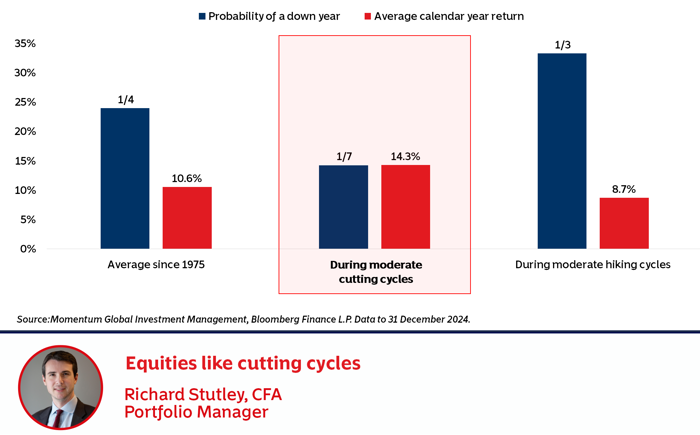
What this chart shows
This chart supports what we know: that equities like interest rate cutting cycles. Looking back at the past 50 years of the Fed funds rate and the S&P 500 Index, we find that calendar years during which interest rates drifted down by up to 1% were positive for the market. During these moderate cutting cycles, the chance of a negative year for the index fell from 1 in 4 years to 1 in 7, and the average return of the index (excluding dividends) increased by roughly 4% to 14.3% per annum. This idea is reinforced by looking at the alternative scenario: during moderate hiking cycles, chances of a negative year increase to 1 in 3 and average returns drop by close to 2%.
Why this is important
Inflation, while less talked about of late, remains critical to the outlook for markets from here. If inflation remains under control, then there’s every chance that fairly orthodox monetary policy – i.e. a moderate cutting cycle – can be used to steer a smooth path for economies, and in that environment the majority of investments should do well.
We should remember that the prospect of a continued moderate cutting cycle provides a powerful underpin to equities, outside of the most extended parts of markets today. But we should also keep in mind that, like any rule, this one is not perfect – in 1990 for example, the Fed fund rate was cut by a percent and yet the S&P still fell -7%. One should therefore continue to look at a range of inputs when deciding how to position portfolios today.
The rest of the world is feeling the ripple effects of developed-market policy and geopolitical shifts; in effect, markets are beginning to price in structural rather than purely cyclical risks — making broad diversification and macro-hedges more relevant.

-
The continued US federal government shutdown continues to delay and disrupt key economic data releases (inflation, retail sales, producer prices), adding uncertainty to economic-policy signals.
-
The dollar extended four straight sessions of decline amid credit concerns, Fed policy uncertainty and political risk, the EUR/USD rose about 1% this week.
-
The recently announced threat of 100% tariffs by Donald Trump on Chinese goods, alongside Chinese rare-earth export curbs, rattled markets and raised fears of a renewed US–China trade escalation, though Trump said the US will “be fine” with China, as the two sides prepare to resume talks this week before a trade truce expires on Nov. 10.
-
Despite the data uncertainties, the US economy continues to show resilience, with insights into manufacturing, housing and regional surveys gaining deeper attention given the data gaps.

-
The government announced tweaks to its planning-system overhaul to boost growth and accelerate house-building, signalling a pro-growth agenda amid fiscal pressures.
-
The International Monetary Fund (IMF) warned that UK inflation risks becoming entrenched, projecting the highest inflation among G7 countries in 2025–26 and suggesting that rate cuts may be some way off.
-
Borrowing costs for UK government debt fell to their lowest in three months (10-year yields below ~4.5%) as global risk-off flows favoured safer assets and the UK signalled fiscal discipline ahead of its November budget.
-
The labour market showed signs of softness: employment estimates fell slightly, unemployment rose to ~4.8% and vacancies continued to decline, raising questions about the resilience of household incomes.

-
European shares (e.g., the STOXX 600) recovered modestly on 13 October after earlier tariff fears (US-China) triggered sharp falls; technology stocks led the rebound.
-
The political crisis in France continued to deepen, with the newly assembled cabinet collapsing within hours and no-confidence motions piling up, raising questions about France’s ability to deliver on EU defence/security and fiscal goals. The S&P downgraded the nation’s credit rating in an unscheduled move.
-
A senior German central banker (Joachim Nagel) urged Europe to adopt a tougher stance in trade with China, warning that Europe risks being undercut in critical supply-chains.
-
Market commentary by private capital heads (e.g., from Apollo Global Management) suggested Europe is “at war with itself” over financial regulation and that regulatory fragmentation is inhibiting investment flows.

-
China’s September export growth surprised to the upside (+8.3% y/y), driven by non-US markets, but the data was overshadowed by renewed US threats of extreme tariffs and China’s own rare-earth export curbs.
-
A Reuters survey indicated China is likely to keep benchmark lending rates (1-year & 5-year LPR) unchanged this month, implying policymakers are holding fire despite weak domestic demand and global headwinds.
-
Shares in Japan fell sharply (e.g., the Nikkei 225 down ~2.6 % on 14 October) amid heightened political uncertainty after the ruling coalition’s junior partner exited and the next prime minister’s path became unclear.
-
Financial contagion fears emanated from the US regional banking sector (e.g., Zions Bank, Western Alliance), prompting global bank-sector risk repricing and a safe-asset bid.
